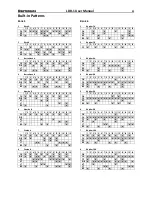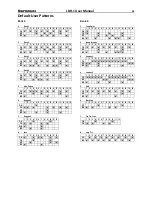
LDB-1 User Manual
20
Connectivity
(continued)
DINsync
DINsync is a standard used by older drum machines, primarily from Roland. DINsync provides a clock
signal and a gate (on/off) signal. The DINsync jack and the MIDI jack are one and the same, so you
cannot use them both at the same time.
The clock input pin on the DINsync jack, and the signal pin on the Clock In jack are connected. Likewise,
the gate input pin on the DINsync jack, and the signal pin on the Gate In jack are connected. Therefore,
you cannot use them both for input at the same time. However, since they are connected, you could
use one set for input and the other for output. For example, if you connect another drum machine to
the DINsync jack, then you can use the LDB-1 Clock and Gate jacks as outputs to your modular synthe-
sizer. Alternately, if you connect your modular synthesizer to the LDB-1 Clock and Gate jacks, then you
can use the DINsync jack as an output to control another drum machine.
MIDI
Notes:
In Play Drums mode, the LDB-1 will respond to MIDI note on messages. See the MIDI Setup
section for details on how MIDI notes are mapped to LDB-1 instruments.
Real-Time Messages:
In any mode in which a song or pattern can play (Play Songs, Play/Edit/Write
Patterns, Edit Triggers, or Setup), the LDB-1 will respond to the following MIDI system real-time messag-
es:
Clock:
Overrides the tempo knob.
Stop:
Stops the currently playing song or pattern immediately.
Start:
Starts playing the current song or pattern at the beginning.
Continue:
Starts playing the current song or pattern at the point at which it stopped.
Song Position Zero:
Sets the song position to the beginning of the song, so that a Continue message will
start it playing from the beginning. This message is handled because some MIDI implementations only
send one Start message and subsequent messages consist of a Song Position Zero message then a Con-
tinue message. Messages that attempt to set the song position to a point other than zero are ignored.
Memory
The LDB-1 contains non-volatile memory. That is, it remembers things even with no power.
When you edit or write patterns, songs, triggers, or setup parameters, the LDB-1 saves your changes to
non-volatile memory when you exit the mode (by switching to a different mode).
If you power off the LDB-1 while still in the Edit or Write mode, any changes you made will be lost. For
example, if you are editing a pattern and you want your changes to be saved, switch to a different mode
(such as Play Patterns) before you power off.
In addition to the patterns, songs, triggers, and parameters that you explicitly change, the LDB-1 also
remembers the current pattern bank and song bank. When you change the pattern or song bank in any
mode, it is immediately saved to non-volatile memory.

































